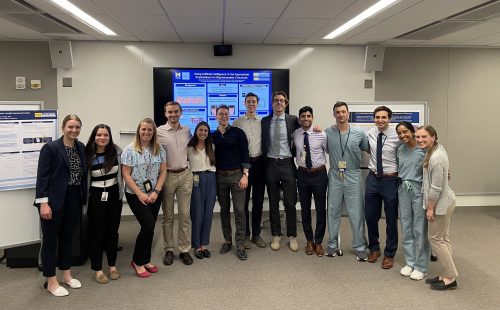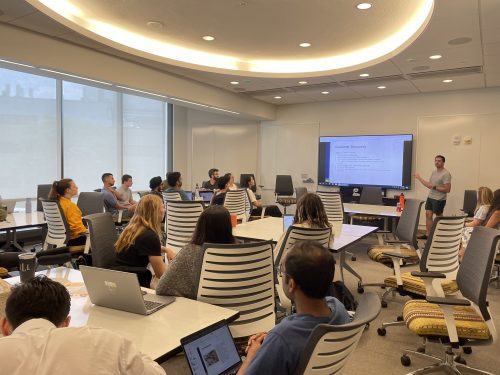The polio vaccine. ECMO. The Bovie. These revolutionary medical innovations have not only improved countless lives but also share a common starting point: the University of Michigan Medical School (UMMS)!

Rising M4 students celebrate the completion of their I&E Capstone projects
As UMMS students, we are fortunate to walk the same halls where brilliant minds have dedicated their efforts. Now, it is our turn to contribute to the strong tradition of innovation and entrepreneurship (I&E) at Michigan.
A recent symposium united medical students who are dedicated to advancing healthcare through innovation, whether it’s leveraging technology, conducting research, or reimagining healthcare systems.
The day began with design thinking presentations by three teams of M1 students. These teams had collaborated on projects for months, utilizing the five phases of design thinking to tackle patient challenges. By empathizing, defining, ideating, prototyping, and testing, they devised innovative solutions aimed to improve the patient experience and health outcomes.
One standout project by “Team Zopf” addressed the concerns of a parent caring for a young patient with amyoplasia. The parent frequently monitored their child’s O2 saturations and performed jaw thrust maneuvers to relieve airway obstruction. Their solution? A low-cost, adjustable device that mechanically maintained the jaw in an elevated position while employing continuous O2 monitoring to alert the parent of prolonged desaturation events.
This solution not only showcased Team Zopf’s empathy towards the parent’s desire to avoid additional surgeries but also demonstrated their creativity – utilizing household objects to craft a functional prototype – and their scientific expertise – explaining an impressive torque diagram and 3D CAD model. They discussed next steps for their design, including prototyping and testing, navigating the regulatory pathway, large scale manufacturing, and determining the market value and impact.

Team Zopf’s Design Thinking presentation (Members: Mike Allevato, Dhanya Asokumar, Mikoto Kobayashi, Anna Riegger, James Schlabach, Jasnoor Singh, Sunny Singh, Daniel Wieczorek, Hannah Xu, and Jess Yen)
The symposium also provided the opportunity to learn from influential voices within our University of Michigan innovation community. We heard from our I&E Path Co-Directors, Dr. David Zopf (Pediatric Otolaryngology-Head & Neck Surgery) and Dr. Sonal Owens (Pediatric Cardiology), and Michigan Medicine surgical residents Dr. Jaes Jones (Neurosurgery PGY-4) and Dr. Taylor Kantor (Integrated Cardiothoracic Surgery PGY-5). The panel explored applications of 3D printing in surgery, virtual reality (VR) in medical education and patient care, and the relationship between industry and academia.
A highlight of the panel was Dr. Owens sharing her experience collaborating with the Stanford Virtual Heart experience, which has now evolved into the Michigan Anatomic Congenital Heart in 3D (MACH3). As M2 students on the Pediatrics rotation, my classmates and I had the opportunity to immerse ourselves in a virtual heart, exploring chambers, vessels, and learning cardiac anatomy. The integration of VR into our curriculum added a whole new dimension to our learning, and I eagerly await its further incorporation. Dr. Owens’ announcement that the new MACH3 program will lead the development of a hypoplastic left heart syndrome (HLHS) module filled the room with excitement. It’s incredible to witness the advancements happening at UMMS in real-time!

Medical students were all ears for Drs. Jones, Kantor, Owens, and Zopf
Next, we moved into M4 presentations. Demetri Monovoukas and Nick Zugris shared their journey launching Scalpel – a free online platform that offers foundational surgical training (think Khan Academy for the Surgery rotation), while also providing 3D printed hardware for suturing practice. Kian Pourak unveiled a 3D-printed surgical knot tying device designed to help trainees master the art of tying knots at the optimal tension, and Michelle Benedict shared a video documenting her experiences working at Apple before entering medical school, adding another unique perspective to the mix.
The symposium’s grand finale was a poster session in Taubman Health Sciences Library, inviting students from all classes to explore the capstone projects of rising M4 students. These capstone projects, a requirement for graduation from the I&E Path of Excellence, showcased students’ innovative laboratory endeavors, collaborations with startups, quality improvement projects, and more. The poster session fostered connections between M1s and rising M4s, who were on the lookout for successors to carry forward their projects once they graduate.

Jeremy Shapiro (rising M4) presents his research using AI to predict blepharoplasty outcomes
As UMMS students, we have the incredible challenge, privilege, and responsibility to carry forward the legacy of medical innovation. We invite incoming students to join us on this mission through the I&E Path of Excellence. Mark your calendars for the 2nd Annual I&E Symposium in June 2024 – all students welcome!
Don’t miss the next Dose of Reality.
Lisa Chionis is a rising MS-4 applying into Otolaryngology-Head & Neck Surgery. She is from Chicago, IL, and attended Washington University in St. Louis, where she was captain of the Women’s Varsity Tennis Team. Lisa is interested in applications of AI in Otolaryngology. Twitter and LinkedIn @lisachionis.
